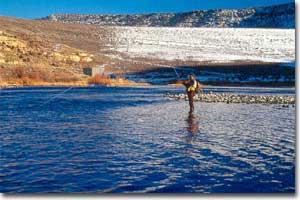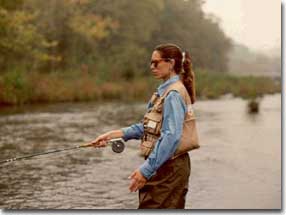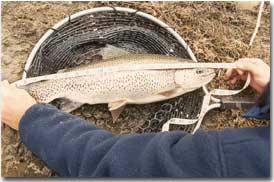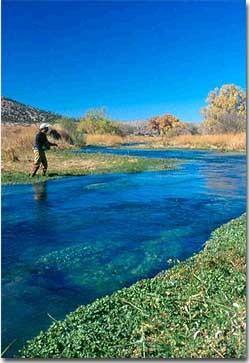Hot Winter Fisheries: Trout Hot spots in New Mexico, Colorado and Oklahoma
Hot Winter Fisheries: Trout Hot spots in New Mexico, Colorado and Oklahoma
It's nearly winter and for most anglers, the rods are tucked safely away in the closet until the Spring Thaw. Read this article at your own peril. What follows is a selection of my favorite Western winter fisheries I find myself visiting each cold season. Included are some classics, along with a few piscatorial gems you may never have read about. Two of the least-known winter angling hotspots (Culebra Creek and the Rio Peñasco) are private and require guide services. Few anglers have ever even heard of these small but productive year-round fisheries, and that's a major part of their appeal. So get out the maps and figure out a way to visit one of these hallowed haunts of mine. San Juan River, New Mexico  Colorful high-desert canyon walls line this cold, wide river, one of the premier trout streams in America. The tailwater is full of heavy trout and focused anglers. It's a popular winter destination, with an armada of watercraft and decked-out fly fishers fighting over three and a half miles of regulated water. Colorful high-desert canyon walls line this cold, wide river, one of the premier trout streams in America. The tailwater is full of heavy trout and focused anglers. It's a popular winter destination, with an armada of watercraft and decked-out fly fishers fighting over three and a half miles of regulated water. Not to worry, the river is so profound, so fecund, that all you need is locate your very own 50-yard radius and you'll be casting to a day's worth of fish. In your staked-out territory, you can cast to long glides, backwater flats, runs, deep pools, channels, riffles and lots of unremarkable, hard-to-figure water. Don't fret, thar's fish down there. The odds are good you will hook up with an 18-inch-plus trout, maybe longer, but the odds are lesser, even for seasoned vets, that you will land the fish. San Juan trout are broad-shouldered and use their strength to take out line and make your reel scream. Many experts rate this tailrace as the number one trout hotspot in America. Combine the austere beauty of the painted high desert with the consistently prolific population of big trout and insect activity and this a guaranteed winter wonderland. Practicalities Location: Northwest New Mexico near Aztec and Farmington. Species: Predominantly rainbow and brown trout. More rainbows in the upper section, more browns in the lower section. Rainbows and cutthroats average 13 to 20 inches with many over 20 inches. Expect to catch several in the 2 to 5 pound range. The brown trout population has increased the last few years, especially in the lower section of the quality waters and below it. The browns get big, too, but aren't as plentiful. Ten-pound browns are caught in the river every now and again. Equipment: 8½- to 9-foot rod for 4- to 6-weight line. Neoprene chest waders and felt soles. Wading staff helpful. Anglers can wade much of the river, especially the upper part, but crossing can be dangerous due to the strong flow and dropoffs. Also, the rocks are covered in moss and very slippery, so wear felt soles. The river is a constant 42 degrees so neoprene waders are a must. Winter storms blow in unexpectedly and fiercely. Bring harsh weather gear. Notes: The San Juan and Green Rivers are arguably the top winter trout fisheries in the West. I recommend hiring a guide if you've never fished the San Juan before, since the techniques the guides and locals employ can make all the difference in catching twenty big trout or talking about the one fish that got away. The only way to float the river is in a boat, usually a MacKenzie boat, no motors. No float tubes. The put-in is usually at the Texas Hole.
 Red River
Red River The Red River is a pretty canyon stream that empties into the Rio Grande. In the river below the ski town of Red River, the stream cascades frothily through steep-walled chutes, drops into deep, turquoise pools, bounces through choppy pocket water and tumbles on its destiny with the Rio Grande. The resident fish tend not to be sizeable, but the stream gets a couple of runs from migrant trout from its larger sister. The appeal of the Red River is the solitude, the wild trout, and the fact that in the dead of winter, with snow all around on the Sangre de Cristos, fishing on the Red River can be a temperate, comfortable endeavor. Dry fly fishing in winter, I might add. Practicalities Location: Red River, New Mexico, in the northern section of the state. Species: Brown, cutthroat, rainbow, and occasionally brook trout. Equipment: 7½- to 8½-foot rods for 3- to 5-weight line. Hip waders are handy but hiking in while wearing waders is bound to be uncomfortable. Anglers might consider hiking in wearing hiking boots with a lightweight pair of wading boots and breathable waders packed in a daypack. If you do hike in waders, be forewarned they could easily get torn up from rocks and brush. Notes: For anybody who has fished for big fish moving up from the Rio Grande in the fall and spring, then you know this hard-to-get-to fishery is one of the best secrets in New Mexico. And despite the crowds around the hatchery, the fishing is usually productive, especially in the canyon's stairstep pools below. Make sure to visit the public sections of the headwaters as winter turns into spring, and then again when the snow has melted. Rio Grande This big river used to enjoy a reputation in the 1950s and 1960s as one of the top trout spots in the nation, but the river's trout population and the numbers of large fish declined in the 1970s and 1980s. To a large degree, the river has recovered. The Rio Grande cuts a mighty path on its 70-mile southward course from Colorado, through the wide valleys of New Mexico. The Rio Grande is a wide freestone river with deep pools, wide glides, boulders, big pocket water, and riffles, inaccessible except in a few places due to the 600- 1,000-foot deep canyon. Various springs feed the river. Pike have become the winter draw on the river. Look for deep, slow pools, fish rainbow trout streamers and hold on. Trout lovers can drop a line for big browns and fat rainbows and a decent population of cutthroat trout. Cast around rocks, along current edges, foam eddies, and at the head and tail of pools. Practicalities Location: The Rio Grande runs for miles north to south out west of Questa and Taos. Species: Rainbow, brown, cutthroat trout, pike. Equipment: For trout, an 8½- to 9-foot rod for 5- or 6-weight lines. Anglers will want an 8- or 9-weight outfit for pike. Pack a daypack, first aid and some warm clothes. You won't need to wade so wear hiking boots with good ankle support. Allow plenty of time to get into the canyon and start hiking out early. Not for the faint of heart — some very steep trails. Notes: Runoff in late May can be heavy, but the Rio Grande is productive year-round. You're in for a serious hike along rugged trails to reach many of the best and out-of-the-way spots. There are a number of trails leading to the river. Most are steep, many are unmarked, and many shouldn't be tried unless you are in good shape. It's a long way down, and a long way back out. If the water is off-color and high, fish to the edges and clearer water. No need to fish when the sun is off the water. Fish late and leave early. For light hiking, the best access to the Rio Grande is at the John Dunn Bridge, west of Arroyo Hondo, at the confluence of the Rio Hondo and Rio Grande. The river can also be reached at the confluence of the Red River and the Rio Grande at the Wild and Scenic River National Recreation Area. And you can always float the river. Despite the rumors of its early death, the Dolores River is still a solid fishery, worth a trip both for the fishing and the incredible scenery. In the 1980s, the high-desert tailwater was well on its way to becoming one of the top trout streams in the country.
 Dolores River, Colorado
Dolores River, Colorado
The lower Dolores is not dead yet contrary to early obituaries. The tailwater offers solitary winter angling, abundant wildlife sightings, and challenging angling in near-spring-creek conditions. This was once one of the top tailwater fisheries in the West, but mismanagement and drought have severely affected the quality of the trout population. Nevertheless, the angling experience in such extreme surroundings is still top-notch. The Dolores River has twelve miles of fishable water, all sorts of lies, and finicky fish. Anglers will need to use long leaders, stalk the trout, and employ cautious approaches. Don't be fooled by the freestone nature of the stream. The Dolores fishes best by downsizing the fly patterns and fishing under the surface with nymphs. The high canyon walls cast long shadows over longer pools on this secluded stream. In the winter, few anglers visit, so you can have entire stretches to yourself. The river is remote, in the middle of nowhere — and that's its chief appeal. Practicalities Location: Southwestern Colorado below McPhee Reservoir west of Durango. Species: Snake River and Colorado River cutthroat, brown, rainbow trout (browns have a self-sustaining population). The river is supplemented with fingerling plantings, and browns and rainbows now the prevail. Equipment: 8½- to 9-foot rod for 4- to 6-weight lines. Neoprene chest waders are preferable most of the year. Felt-soled wading boots are a must. Hip waders are useful when the water is low. Notes: Tailwater below reservoir; freestone above. This 12-mile tailwater has long, wide, still glides and pools, plenty of tricky crosscurrents, some pocket water around boulders and submerged rocks, lots of slack water, and some nice runs. The Dolores has a lot of public access, but anglers must be aware of private property above and below the reservoir. Anglers will have no problem accessing the Dolores even in winter when the gate closes. All trout must be immediately returned to the water. Stay in Durango and enjoy the quaint 19th-century atmosphere of the ski town. It's about a 90-minute drive to the Dolores and you can fish the Animas through and below town all year. South Platte River, Colorado The only thing wrong with the South Platte River is that so many other fly fishers are in on it. This is one fine river, full of big trout. In the winter, the South Platte is less crowded (only an hour and a half from Denver) and if you are inclined to hike, scenic Cheesman Canyon provides excellent angling to trout holding in pocket water and big pools. The South Platte from Deckers and below lies in a wide open park, subject to cold winter winds. Finding your own turf is easier than in Cheesman. Both in the canyon and in the park, the fish are both hefty and discerning. Beginning anglers will probably not fare as well as seasoned fishermen. The river has tricky currents and clear water, and the trout, while not skittish, rise and refuse patterns with regularity. Any kind of drag, even on nymphs, will put the trout off. Fish small midge larva patterns on long leaders for the best results. Practicalities Location: Central Colorado, southwest of Denver about an hour and a half. Species: Rainbow and brown trout (finicky and usually big). Tackle: 8½- to 9-foot rod for 3- to 5-weight line (5-weight to combat the park winds). Neoprene waders, felt-soled boots. Layer for warmth. Notes: This tailwater runs through canyon and open park. The Platte is best known for the South Park area, especially its three-mile stretch below Spinney Mountain Reservoir, and the 11 miles below Cheesman Dam, but the entire river has excellent fishing for rainbow and brown trout, many reaching over 20 inches long. The main attraction of the South Platte is that if you intend to travel through Denver, you can easily make a side trip to the South Platte River. You might find yourself sharing a pool in the canyon or fighting a wicked winter wind whipping through the park, but after all, it's the dead of winter and you will be fishing to large trout. Mountain Fork River, Oklahoma The Ouachita Mountains provide a pleasant backdrop to fishing in the pools and riffles of this small, clear tailwater. In the fall and early winter, the trees and bushes are alive with reds and oranges, and this is when the fishing for rainbow and big brown trout is at its best. In the lower sections of the river, the cypress trees belie the fact that this tailrace is an excellent trout producer. If the skies are overcast, the trout can be found in the riffles feeding on the surface. If the sun is shining, the trout tend to hide in the head and tail of the pools and off the numerous ledges in the river. Mountain Fork River has quietly become a popular trout fishing locale for Oklahomans, Texans and Arkansans, especially from November to March. While most anglers fish Spillway Creek, a diversion of Mountain Fork River, if you want to catch the big ones, if you want to fish the 100-yard wide stretches of the river, if you want to catch lots of trout, then fish downstream of the state park. Practicalities Location: Southeastern Oklahoma, north of Broken Bow 10 miles. The river is three and a half hours northeast of Dallas, Texas. Species: Stocked rainbow and brown trout with some reproduction. In the park, on Spillway Creek, average sizes run about 9 – 12 inches. In the lower sections, anglers will catch more browns and larger average-size fish. A 2-pound fish is not uncommon. Equipment: 8- to 9-foot rod for 4- to 6-weight line. Notes: This twelve-mile tailwater is loaded with a diversity of holding water ranging from pools to runs to wide, lake-like flats, a few riffles, pocket water with plenty of underwater cover, and even some undercut banks. When the water rises, it rises quickly. If you hear the siren, get out immediately. Be aware of the water levels by keeping a rock or tree level in sight. The rocks in the river are slick and the chances of a wader falling are good. Wear felt-soles, use a wading staff, take your time, fish with a buddy, and be careful. Culebra Creek, Colorado Never heard of it, you say? This tailwater holds four species of trout, all of them on the hefty side: rainbows, browns, cutthroats and brookies. Anglers can catch trout in the 2 to 5 pound range with a legitimate shot at trout measuring in at 20 inches and over. The Culebra (means which "snake" in Spanish) meanders through a scenic, agricultural valley, with long, clear glides, deep bend pools and shallow gravel bars. You won't find Culebra Creek in any of the fishing guidebooks. Those who fish it don't generally talk about it, preferring to keep this little secret a secret. In places, the river turns and snakes through the valley, ideal for wide-open casting. In these open glides and bend pools, the fish can see you so you'll have to stalk and soft-toss casts right over their feeding lanes. But in other spots, the riverbanks are brushy and require tight, accurate casts. And did I mention these big trout are a tad finicky? A true trophy trout hunter's theme park. Practicalities Location: Just south of town of San Luis in southern Colorado. Anglers will want to base operations out of Taos, just an hour and a half away. Species: Rainbow, brook, cutthroat and brown trout — most of them large. Equipment: 8- to 9-foot rod for 4- to 6-weight line. Hip waders are ideal. Notes: Private spring creek-like tailwater below Sanchez Reservoir. The Culebra is one of the best angling opportunities in the southwest for big trout. You must have a guide to fish the river (although there is a short, frequently poached public section). The river is not for beginners since these lunkers are leader-shy, have plenty of food to eat and the water is invisibly clear. In the valley, with snow on the surrounding peaks, the valley temperature is relatively warm. Contact: Los Rios Anglers in Taos (505-758-2798), Reel Life in Albuquerque (505-268-1693) for guide services. Guide trips on the Culebra begin at $250 for one person, $300 for two persons. Some guides add in a $60 rod fee.
 Rio Peñasco, New Mexico Rio Peñasco, New Mexico How about a spring creek in the middle of nowhere loaded with big trout, with very little angling pressure, fishable all through the winter? The Rio Peñasco flows in southern New Mexico, past high desert sage and juniper through a valley flanked by low-slung hills. The Rio Peñasco teems with sizeable wild brown and rainbow trout, and is fishable all year long, with a constant temperature in the mid-50s. The river's glassy surface is tough on beginning anglers, whose days will be fraught with casting and mending disasters. The river is deceptively deep, an illusion caused by the amazing clarity of the water and the thick watercress swaying in the gentle currents. But under the cut banks and between the watercress channels, the Rio Peñasco holds big browns and rainbows, many over five pounds. Practicalities Location: Southern New Mexico near Cloudcroft and Ruidoso. Species: Rainbow and brown trout. Equipment: 8- to 9-foot rods for 4- to 6-weight line. Notes: Think small. Small flies, small tippet. This is one of the premier fisheries in the West. Few anglers know about it, but many anglers fish it incorrectly. If you like to fish with big flies, use streamers. The Powell Ranch stretch does not advertise, but its four or five miles is fishable, if not exactly prolific. And it only costs $5 to access. The Bernard Cleve section, the only public water on the river, has plenty of gravel, which means the fall spawners end up on this water come autumn, although it does get awfully low at times. Contact: There are three main sections of the Rio Peñasco: the Foley Ranch, the Mulcock Ranch, and the Bernard Cleve Ranch, although parts of these (and a few others) often share the river as a boundary. Both the Foley and Mulcock sections, about seven miles of water, charge day fees and require anglers to fish with a guide. The total cost for each river is $300 a day. To fish the Foley section, the most pristine section of this spring creek, anglers should make reservations through the Reel Life shops in Santa Fe (505-995-8114), or Albuquerque (505-268-1693). To fish the Mulcock section, anglers can make reservations through the Reel Life Flyshops or by calling Mulcock Ranch directly (505-687-3352 or 746-6785. This article is courtesy of Mark Williams
|